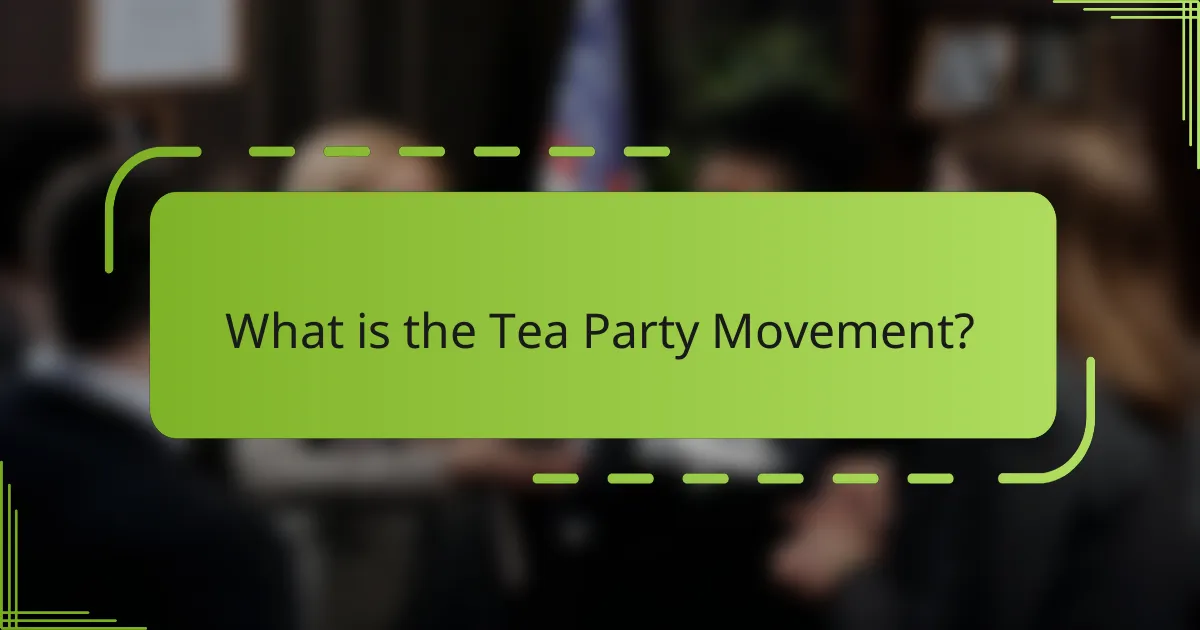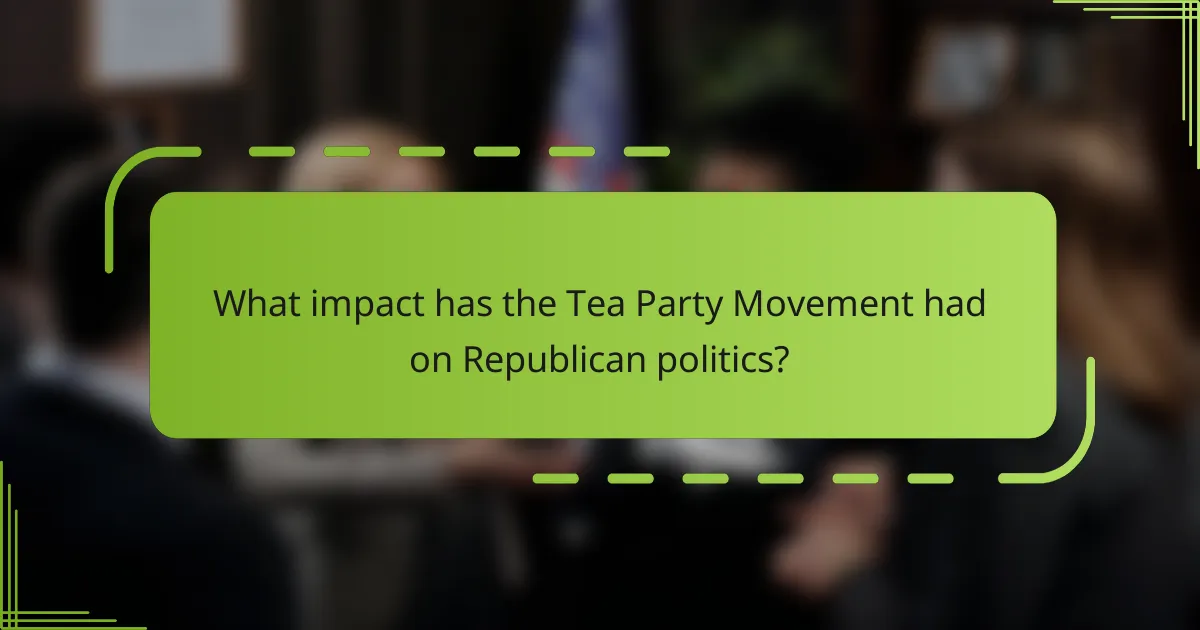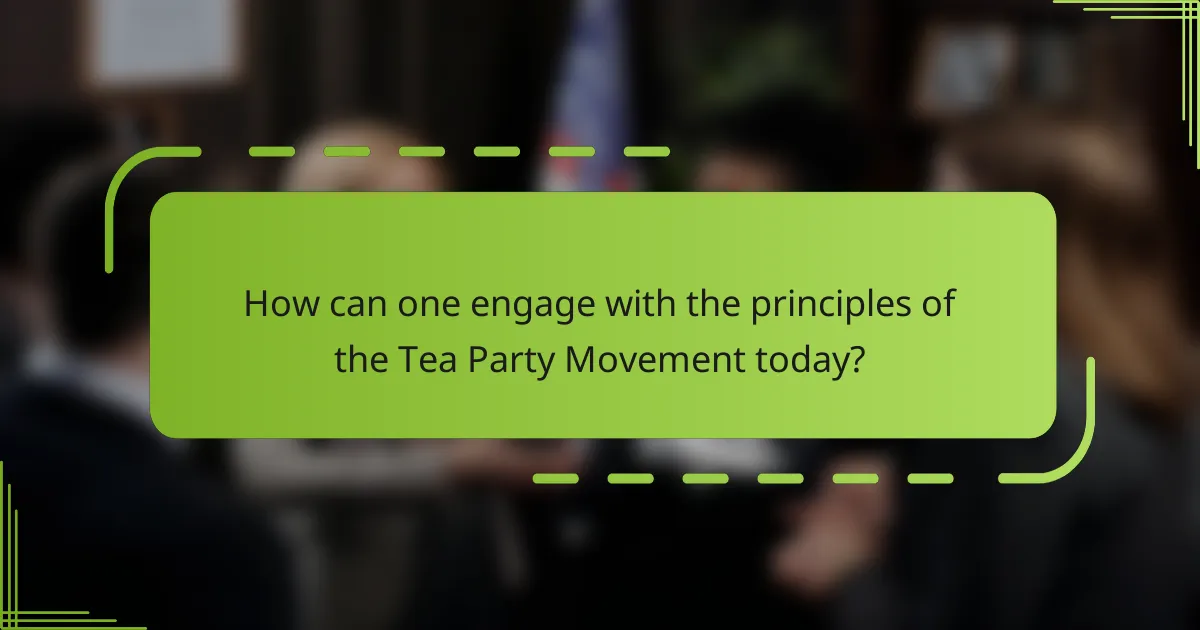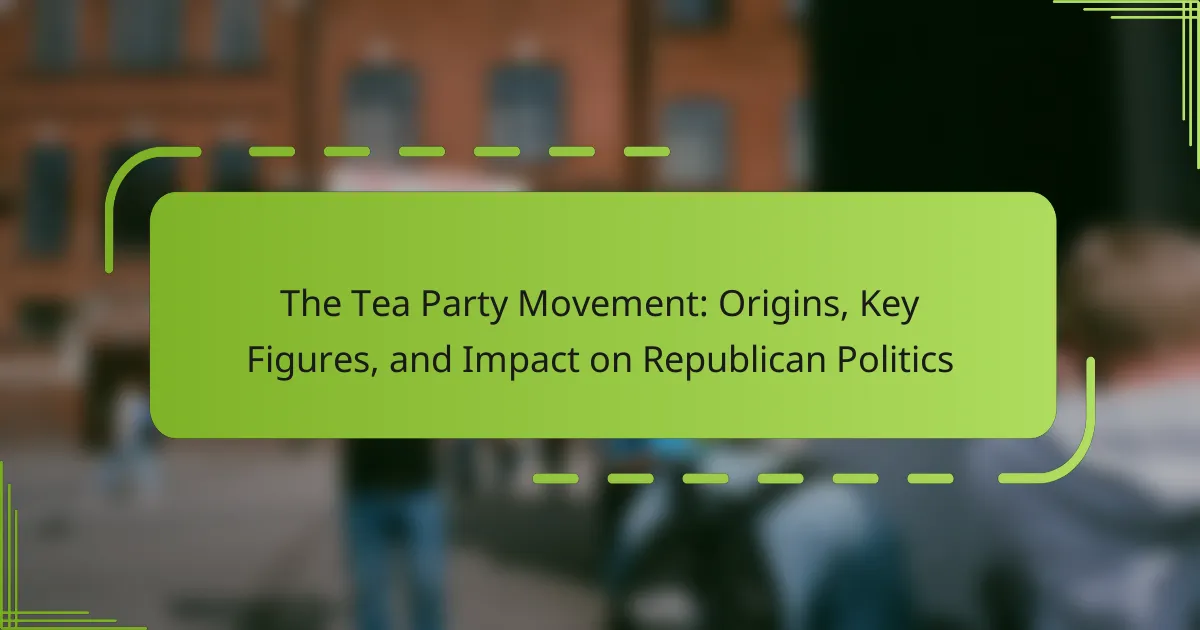
What is the Tea Party Movement?
The Tea Party Movement is a conservative political movement in the United States. It emerged in the late 2000s, primarily in response to what participants viewed as excessive government spending and overreach. The movement is characterized by its advocacy for limited government, lower taxes, and a strict interpretation of the U.S. Constitution. It gained significant attention after a series of protests in 2009, particularly against the Affordable Care Act. The movement is often associated with grassroots organizing and has influenced Republican Party politics significantly. Key figures include politicians like Sarah Palin and Ted Cruz, who have publicly supported its principles. The Tea Party Movement played a crucial role in the 2010 midterm elections, helping to elect several conservative candidates to Congress.
How did the Tea Party Movement originate?
The Tea Party Movement originated in the United States in early 2009. It emerged as a response to the financial crisis and government spending under the Obama administration. The movement was galvanized by a televised rant from CNBC correspondent Rick Santelli. Santelli criticized government bailouts and called for a “tea party” to protest against excessive taxation. Grassroots organizations quickly formed, focusing on limited government and fiscal conservatism. The movement gained significant traction through social media and local activism. By mid-2009, it had organized numerous rallies and events across the country. The Tea Party Movement played a crucial role in shaping Republican politics during the 2010 midterm elections.
What historical events contributed to the rise of the Tea Party Movement?
The rise of the Tea Party Movement was significantly influenced by the 2008 financial crisis. This crisis led to widespread economic instability and discontent among American citizens. The government’s response, including the Troubled Asset Relief Program (TARP), sparked outrage over perceived government overreach. Additionally, the election of Barack Obama in 2008 intensified concerns about federal spending and taxation. The stimulus package and healthcare reform proposals further fueled the movement’s anti-government sentiment. Grassroots organizing began in early 2009, with protests and rallies gaining momentum. Events like the Tax Day Tea Party on April 15, 2009, exemplified this growing activism. These historical events collectively created an environment ripe for the Tea Party’s emergence.
Who were the key influencers in the early stages of the Tea Party Movement?
Key influencers in the early stages of the Tea Party Movement included figures such as Ron Paul, Sarah Palin, and Glenn Beck. Ron Paul, a former Congressman, advocated for limited government and fiscal responsibility, resonating with Tea Party ideals. Sarah Palin, the former Governor of Alaska, energized grassroots supporters with her populist message. Glenn Beck, a media personality, provided a platform for Tea Party discussions through his television show. These individuals helped to shape the movement’s ideology and mobilize supporters across the United States. Their influence was evident in rallies, media appearances, and the promotion of core Tea Party principles.
What are the core beliefs and principles of the Tea Party Movement?
The core beliefs and principles of the Tea Party Movement include limited government, fiscal conservatism, and strict adherence to the U.S. Constitution. Members advocate for reducing the federal deficit and opposing tax increases. They emphasize individual liberties and free markets. The movement emerged in response to perceived government overreach, particularly during the Obama administration. It gained prominence in 2009, influencing Republican candidates and policies. The Tea Party promotes state sovereignty and a strict interpretation of the Constitution. These principles resonate with a significant segment of the American electorate, shaping political discourse.
How do the beliefs of the Tea Party align with traditional Republican values?
The beliefs of the Tea Party align closely with traditional Republican values by emphasizing limited government, fiscal conservatism, and individual liberties. The Tea Party advocates for reduced government spending and lower taxes, mirroring the traditional Republican stance on economic issues. They prioritize the Constitution and advocate for a strict interpretation of its principles, reflecting the Republican focus on constitutionalism. Additionally, the Tea Party’s emphasis on personal responsibility and free markets aligns with the foundational beliefs of the Republican Party. Their grassroots activism seeks to hold elected officials accountable, reinforcing the Republican value of transparency in government. Overall, the Tea Party embodies a revival of core Republican ideals, especially during the late 2000s.
What specific policies does the Tea Party Movement advocate for?
The Tea Party Movement advocates for limited government, fiscal responsibility, and free markets. They prioritize reducing the national debt and federal budget deficit. Additionally, they support lower taxes and less regulation on businesses. The movement also emphasizes strict adherence to the U.S. Constitution. They often oppose government intervention in healthcare and advocate for states’ rights. Grassroots activism is a hallmark of their approach. The Tea Party emerged as a response to perceived government overreach during the Obama administration. Their policies have significantly influenced Republican politics since their rise in 2009.
Who are the prominent figures in the Tea Party Movement?
Prominent figures in the Tea Party Movement include Sarah Palin, Michele Bachmann, and Ron Paul. Sarah Palin gained national attention as the 2008 Republican vice-presidential nominee. Michele Bachmann served as a U.S. Representative and was a vocal advocate for the movement. Ron Paul, a former Congressman, emphasized limited government and fiscal responsibility. Other notable figures include Marco Rubio and Ted Cruz, who aligned with Tea Party principles during their Senate campaigns. These individuals played significant roles in shaping the movement’s agenda and influencing Republican politics. Their collective efforts helped propel the Tea Party into the national political spotlight.
What roles have individuals like Sarah Palin and Ron Paul played in the movement?
Sarah Palin and Ron Paul have played significant roles in the Tea Party movement. Sarah Palin emerged as a prominent figure after her vice-presidential candidacy in 2008. She energized grassroots supporters with her conservative views and anti-establishment rhetoric. Palin’s endorsements helped elevate key candidates in the 2010 midterm elections. Ron Paul, known for his libertarian principles, influenced the movement’s focus on limited government and fiscal responsibility. His 2008 and 2012 presidential campaigns attracted a dedicated following. Both figures contributed to shaping the movement’s identity and priorities within the Republican Party. Their advocacy emphasized a return to constitutional principles and reduced federal intervention.
How have grassroots leaders influenced the direction of the Tea Party?
Grassroots leaders have significantly influenced the direction of the Tea Party by mobilizing local support and shaping its agenda. They have organized rallies and events, increasing visibility and engagement among conservative voters. Leaders like Sarah Palin and Michele Bachmann have provided national recognition and legitimacy to the movement. Their emphasis on limited government and fiscal conservatism resonated with many Americans during the economic crisis of 2008. Additionally, grassroots leaders have utilized social media to disseminate information quickly and effectively. This grassroots organization has directly impacted the Tea Party’s political strategies and candidate endorsements. The influence of these leaders has helped to steer the Republican Party further to the right, emphasizing anti-establishment sentiments. Their efforts have led to significant electoral successes, particularly in the 2010 midterm elections, where Tea Party-backed candidates won numerous seats in Congress.

What impact has the Tea Party Movement had on Republican politics?
The Tea Party Movement significantly influenced Republican politics by shifting the party’s ideology towards more conservative positions. This movement emerged in 2009, primarily in response to the policies of President Barack Obama. It emphasized limited government, fiscal conservatism, and a strict interpretation of the Constitution. The movement mobilized grassroots activism, leading to increased voter engagement among conservatives. In the 2010 midterm elections, Tea Party candidates won numerous congressional seats, reshaping the Republican majority. This electoral success pushed the party leadership to adopt more hardline stances on issues such as taxation and healthcare. The Tea Party also contributed to the rise of populist sentiments within the Republican base. Overall, the movement redefined the party’s direction and strengthened its conservative identity.
How did the Tea Party Movement shape the 2010 midterm elections?
The Tea Party Movement significantly influenced the 2010 midterm elections. It mobilized grassroots support for conservative candidates. The movement focused on issues like limited government and fiscal responsibility. Many Tea Party-backed candidates won Republican primaries. This led to a shift in the Republican Party towards more conservative policies. The movement energized voter turnout among conservatives. In the 2010 elections, Republicans gained 63 seats in the House of Representatives. This marked one of the largest gains for the party in decades.
What strategies did the Tea Party use to mobilize voters during the elections?
The Tea Party mobilized voters through grassroots organizing, rallies, and targeted messaging. They utilized social media to spread their message rapidly. Local chapters were formed to engage community members directly. The movement focused on issues like taxation and government spending to resonate with conservative voters. They also endorsed specific candidates who aligned with their values. Fundraising efforts were significant, allowing them to support campaigns financially. Additionally, the Tea Party leveraged existing networks of conservative activists. Their strategies resulted in increased voter turnout in key elections, particularly in 2010.
What were the outcomes of the Tea Party’s influence on election results?
The Tea Party significantly influenced election results, particularly in the 2010 midterm elections. The movement helped Republican candidates gain over 60 seats in the House of Representatives. This shift resulted in a Republican majority and altered the legislative landscape. The Tea Party’s focus on limited government and fiscal conservatism resonated with voters. In several primaries, Tea Party-backed candidates defeated established Republicans. This outcome showcased the movement’s power in shaping candidate selection. The influence persisted in subsequent elections, impacting Republican strategies and policies. Overall, the Tea Party’s influence marked a notable shift in American politics.
In what ways has the Tea Party Movement altered the Republican Party’s platform?
The Tea Party Movement has significantly altered the Republican Party’s platform by emphasizing limited government, fiscal conservatism, and strict adherence to the Constitution. This grassroots movement emerged in 2009, primarily in response to the economic policies of the Obama administration. It mobilized a large base of conservative voters who prioritized reducing federal spending and taxes.
The movement has also influenced the party’s stance on healthcare, leading to strong opposition to the Affordable Care Act. Additionally, the Tea Party has pushed for a stricter immigration policy and a focus on states’ rights. Key figures, such as Senator Rand Paul and Representative Michele Bachmann, have become prominent voices advocating for these principles.
The impact of the Tea Party is evident in the 2010 midterm elections, where numerous candidates aligned with its ideology won seats in Congress. This shift has led to a more right-leaning Republican Party platform, distancing it from moderate positions previously held by some party members. Overall, the Tea Party Movement has reshaped the Republican Party’s identity and policy priorities.
How has the Tea Party’s focus on fiscal conservatism changed party priorities?
The Tea Party’s focus on fiscal conservatism has significantly shifted Republican Party priorities. It emphasized reducing government spending and lowering taxes. This movement led to a stronger anti-deficit stance within the party. Candidates began prioritizing fiscal issues over social conservatism. The Tea Party influenced the party’s platform during the 2010 midterm elections. It resulted in the election of several fiscally conservative lawmakers. These lawmakers often challenged established party leaders. The movement’s impact is evident in the ongoing emphasis on budgetary restraint.
What challenges has the Republican Party faced due to the Tea Party’s influence?
The Republican Party has faced significant challenges due to the Tea Party’s influence. The Tea Party has pushed for strict adherence to conservative principles. This has led to internal divisions within the party. Moderate Republicans often clash with more extreme Tea Party members. Candidates aligned with the Tea Party have primaried established Republicans. This has resulted in the loss of some traditional Republican seats. Additionally, the focus on limited government has complicated bipartisan negotiations. The Tea Party’s influence has shifted the party’s overall platform further to the right.
What are the long-term implications of the Tea Party Movement on Republican politics?
The long-term implications of the Tea Party Movement on Republican politics include a shift towards more conservative ideologies and increased grassroots activism. The movement has influenced the Republican Party’s platform, emphasizing limited government and fiscal conservatism. This shift has resulted in the election of more conservative candidates in primaries. The Tea Party’s focus on anti-establishment sentiments has also led to tensions within the party. As a result, traditional Republican leaders have faced challenges from more extreme factions. The movement has reshaped the party’s electoral strategies and voter engagement approaches. Overall, the Tea Party has left a lasting impact on the Republican Party’s identity and direction.
How might the Tea Party Movement affect future Republican candidates?
The Tea Party Movement may significantly influence future Republican candidates by prioritizing fiscal conservatism and limited government. This movement has reshaped the party’s base, emphasizing grassroots activism and strong opposition to tax increases. Candidates may adopt more extreme positions to align with Tea Party supporters. The movement has also encouraged primary challenges against establishment candidates, leading to a more ideologically rigid party. For example, in the 2010 midterm elections, Tea Party-backed candidates won numerous congressional seats, demonstrating their electoral power. As a result, future Republican candidates may feel pressured to adopt the movement’s principles to secure nominations and voter support.
What lessons can be learned from the Tea Party Movement’s impact on political strategy?
The Tea Party Movement teaches important lessons about grassroots mobilization in political strategy. It demonstrates the effectiveness of local organizing to influence national politics. The movement successfully harnessed social media to amplify its message and engage supporters. Its focus on specific issues, like taxation and government spending, resonated with many voters. This led to significant electoral victories for candidates aligned with its values in the 2010 midterm elections. Additionally, the movement highlighted the importance of ideological purity within a political party. It showed that a dedicated base could challenge established party leaders. This impact reshaped the Republican Party’s direction and priorities moving forward.

How can one engage with the principles of the Tea Party Movement today?
One can engage with the principles of the Tea Party Movement today by participating in grassroots activism. This includes joining local Tea Party groups that focus on limited government and fiscal responsibility. Attending town hall meetings allows individuals to voice concerns to elected officials. Volunteering for campaigns that align with Tea Party values promotes candidates who prioritize these principles. Engaging in online forums and social media discussions helps spread awareness of Tea Party issues. Additionally, educating oneself on constitutional rights and government accountability reinforces the movement’s core beliefs. This approach reflects the original intent of the Tea Party, which emerged in response to perceived government overreach.
What actions can individuals take to support Tea Party ideals?
Individuals can support Tea Party ideals by advocating for limited government and fiscal responsibility. They can engage in grassroots organizing to promote these principles. Attending local meetings and rallies helps build community support. Writing to elected officials about issues aligned with Tea Party values is also effective. Volunteering for campaigns that reflect these ideals strengthens their impact. Educating others about the principles of the Tea Party can raise awareness. Supporting candidates who prioritize constitutional governance is crucial. Contributing to organizations that align with Tea Party goals furthers their mission.
How can grassroots activism influence local politics in line with Tea Party values?
Grassroots activism can significantly influence local politics by mobilizing community members around Tea Party values. This activism often emphasizes limited government, fiscal responsibility, and individual liberties. Local groups organize town hall meetings to discuss issues aligned with these values. They also engage in voter registration drives to increase participation among like-minded individuals.
Tea Party activists frequently endorse candidates who reflect their principles. They utilize social media platforms to spread their message and rally support. Research indicates that grassroots movements can sway local elections by energizing voters and creating a sense of urgency. The impact of grassroots activism is evident in the 2010 midterm elections, where Tea Party candidates won numerous local and state offices.
What resources are available for learning more about the Tea Party Movement?
Books such as “The Tea Party: A Brief History” by Michael Patrick Leahy offer in-depth insights. Online platforms like the C-SPAN website provide video archives of Tea Party events and discussions. Research papers, including “The Tea Party Movement: A New American Revolution?” from the University of California, analyze its political impact. Documentaries like “Tea Party: The Documentary” explore the movement’s origins and key figures. Websites like the Tea Party Patriots offer resources and updates on current activities. Academic journals often publish articles on the movement’s influence on Republican politics.
The Tea Party Movement is a conservative political movement in the United States that emerged in the late 2000s, primarily as a reaction to perceived excessive government spending and overreach. This movement is characterized by its advocacy for limited government, lower taxes, and strict adherence to the U.S. Constitution. Key influencers such as Sarah Palin and Ron Paul played significant roles in shaping its ideology and mobilizing grassroots support. The article explores the origins of the movement, its core beliefs, prominent figures, and its substantial impact on Republican politics, particularly during the 2010 midterm elections. Additionally, it discusses the movement’s long-term implications for the Republican Party and how individuals can engage with its principles today.
